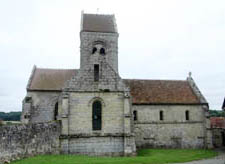Cerseuil (Aisne, France) - Saint-Pierre
- Disclaimer
The dating found here is based on the work of John James, and is meant on this site to serve as a starting point. James' dating is derived from a system that uses his interpretation of the development of capitals over time as the basis for chronology, among other factors. His goal is to refine the dating to within years rather than decades. I have not fully embraced James' methodology, and will be developing this page from its current state to one which is admittedly more conservative. The relative expenditure values found in the Timeline are also based on James' work, and I believe these to be reasonably reliable. They are intended only to give a sense of the amount of work involved in each decade.
I have added the idea of the "project" as a way of separating work in buildings. In my mind, a "project" is a discrete section of work in a building that resulted from the one-time acquisition of funding. "Projects" are generally separated by at least a decade where no work was being done. It is my view that it would have been unwise to start a "project" that could not be finished and protected from the elements, and as such a "project" usually involved a wing or multiple wings of a building, from floor to roof. Rural churches, which could only secure small amounts of funding at irregular intervals, often were the result of many small projects, while the great churches, which benefitted from relatively consistent funding, may have involved only a few large projects.
I have added the idea of the "project" as a way of separating work in buildings. In my mind, a "project" is a discrete section of work in a building that resulted from the one-time acquisition of funding. "Projects" are generally separated by at least a decade where no work was being done. It is my view that it would have been unwise to start a "project" that could not be finished and protected from the elements, and as such a "project" usually involved a wing or multiple wings of a building, from floor to roof. Rural churches, which could only secure small amounts of funding at irregular intervals, often were the result of many small projects, while the great churches, which benefitted from relatively consistent funding, may have involved only a few large projects.
- Timeline with Relative Expenditure (if available, in building units)
 |
 |
 |
 |
 |
 |
- Project A - Earlier - Phase 1 -
There may have been a small church with a round east end, as the new building appears to have been constructed around an existing structure;
- Project B - 1120s - Phase 2 - w nave (a)
The nave was constructed, starting with the west front, probably to the west of an earlier entrance; the new nave was built around the earlier nave, and was intended to have aisles; these were never completed.
- Project B - 1120s - Phase 3 - nave (c)
The upper part of the nave and west window; once the nave was roofed over, the earlier nave was likely dismantled;
- Project B - 1120s - Phase 4 - crossing
The crossing inserted between the new nave and the older east end, with capitals and archway;
- Project C - 1190s - Phase 5 - south
The south transept was added and vaulted; its design indicates that it did not meet up with the earlier building; its vault was also much lower than the later crossing, and the connection between the two is unorthodox;
- Project C - 1200s - Phase 6 - north
The north transept was begun to the level of the sills; the opening from the crossing was created, and the walls were brought up to the sills; evidence seen in the crossing piers suggests that the original apse was still in place;
- Project C - 1210s - Phase 7 - east
The east end was constructed and both it and the north were vaulted, connecting the north and south transepts; once complete, the original apse was removed so that the crossing could be constructed along with the tower;
- Project D - 1230s - Phase 8 - crossing (c)
The crossing piers were completed on all four corners, and the north transept was raised to its full height; both the north transept and crossing were vaulted; after this the room above the crossing was completed;
- Project D - 1240s - Phase 9 - tower II
The upper levels of the tower were constructed;
